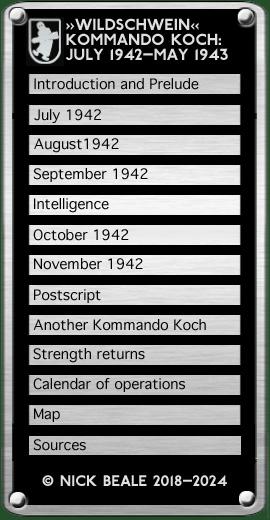|
A very different account of Kdo. Koch was given in captivity by the former Operations and Signals Officers of Stab FAGr. 122. As far as these men were concerned, Koch’s unit had moved from Köthen to Trapani in the late summer of 1942 with six He 111. It had been attached to FAGr. 122, carrying out night radar reconnaissance along the North African coast as far west as Philippeville (Skikda, Algeria). In the course of these operations the Kommando tried out a captured British ASV set (appreciated for its good lateral coverage) alongside the homegrown Rostock and Lichtenstein-S. These German sets were unreliable and needed experienced personnel both to operate and to service them but when FuG 200 Hohentwiel became available it offered a much better angle of search and Koch’s specialists trained all of FAGr. 122’s observers to use it. As the foregoing account has shown, other units (e.g. 2.(F)/123 and KG 100) were using search radars at the time but apparently the prisoners were unaware of what was happening in Fliegerkorps X’s area. It may however be relevant that a detachment from FAGr. 122 under Obltn. Rolf Fritzel, the unit’s Adjutant, was operating three Ju 88 A-4 from Kalamaki—where Kdo. Koch’s Wildschweine were also based—in September 1942. This shows that Kdo. Koch’s responsibilities extended beyond Fliegerkorps X and listening/jamming, and in fact there was at least one search aircraft of the unit operating alongside the Greece-based jammers. If the power requirements of the jamming transmitters were as great as was claimed (see above) it seems unlikely individual aircraft would have been fitted with both these and a search radar, leaving single-role machines altogether more probable. The Kriegsmarine, uncomfortably aware of British capabilities in the field, was kept abreast of German progress with shipping-search radar, the Luftwaffe advising on 26 June 1942 that it had developed three types:
To date, 20 Rostock had been built and the first two were to be installed in Fw 200 aircraft of Luftflotte 5 for operations over northern waters. On 2 August it was reported that one of these machines had picked up a target “for the first time in the fog, at a distance of about 20 km”, NE of Iceland even though no visual contact ensued. This may have been the earliest success for a German ASV but it was not the first such sortie. During the morning of 30 July a Ju 88 of 2.(F)/123 had made a Lichtenstein test flight while that afternoon the same unit flew a radar reconnaissance of the seas between Egypt and Crete. On 4 August, Kesselring’s HQ ordered that from the night of the 5th there were to be Lichtenstein operations to reconnoitre British sea traffic between Alexandria and Haifa. Security was such that no reports were to be sent while in flight, but were instead to be made after landing. British Intelligence’s assessment was that: Prisoners in 1941 mentioned Lichtenstein … as night fighter apparatus. There have been no later references. Present references suggest the name … is being used as cover for the German A.S.V. known to have been recently introduced. Possible interpretation is that an early form of airborne RDF … has been modified for use as A.S.V. On the afternoon of 6 November, Luftwaffe authorities in Sardinia were mustering forces against the Allied convoys approaching French North Africa they planned to shadow the invasion force with two ASV-equipped He 111 prior to an attack at dawn on the 7th. They were to maintain contact the following night as well, operating from both Cagliari-Elmas and Trapani. Those elements of the Kommando concerned with search radar were busy on Italian soil until February 1943 when the main body returned to Köthen, leaving only a small group of specialists behind. Their Heinkels had by then been handed over to FAGr. 122 but these proved too slow and FuG 200 was installed in Ju 88s instead. Repair and maintenance of airborne radar was carried out in Grosseto’s workshops. Men of Kommando Koch were among the heavy toll of casualties when Grosseto was bombed on 26 April 1943. These included: Gefr. Walter Graf, Obgefr. Albert Lampe, Gegr. Hans Müller, Obgefr. Erich Peil, Gefr. Josef Stahlschmidt.and Gefr. Wolfgang Türke. The radar workshops were bombed out on 20 May and so sets had to be returned to Köthen for major repairs. Again the Kommado lost some of its members including Hptm. Josef Schwaighart and Obgefr. Horst Juse.
An Allied analysis of German operations early in 1943 noted a single flight by “ASV He 111, Trapani” in each of the weeks 27 February–5 March and 6–12 March, alongside this comment: “Probable that most of original detachment given up to KG 26”. An Italian document captured in Augusta, Sicliy recorded that an He 111 had detected an Allied submarine with a Radiolocalizzatore (“radio localiser”) SE of Pantelleria on 3 February.
On 1 July 1943, units of Fliegerkorps II had Lichtenstein and Hohentwiel aircraft as follows:
The occupation of Frosinone airfield reported by FAGr. 122 on 17 June included 2 (1) aircraft of Kdo. Koch while on 20 July a lone He 111 of the Kommando was present. continued on next page …
|
|||||||||||||||||||||||||||||||||||||||||


